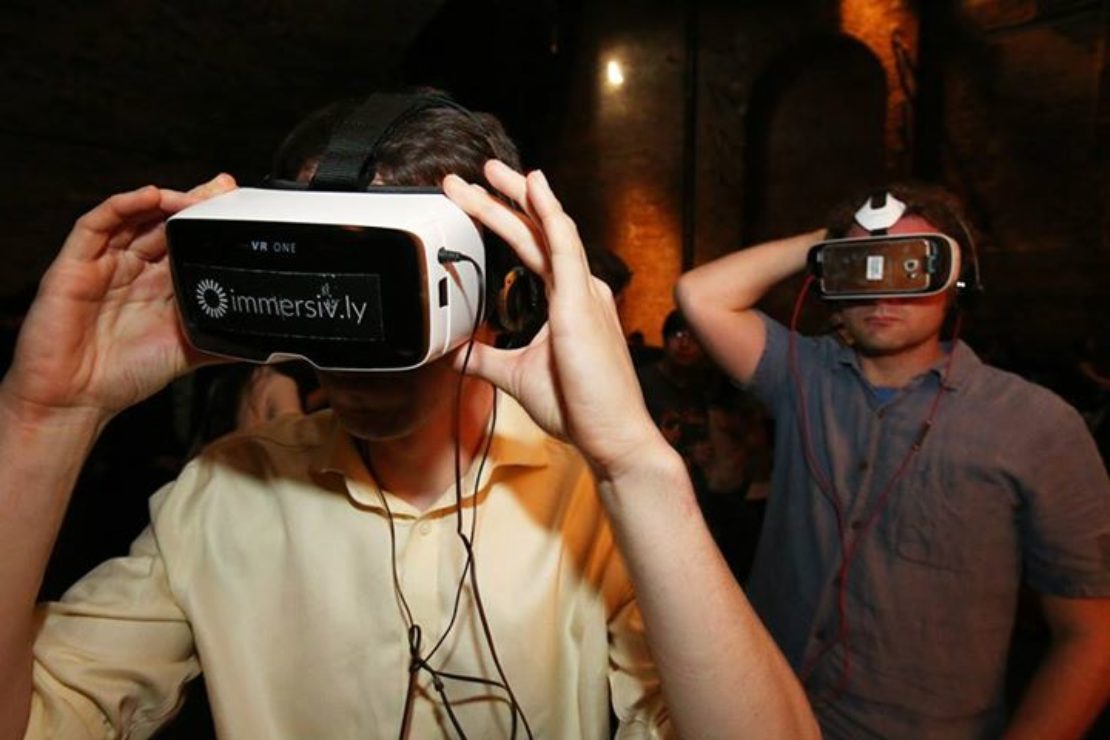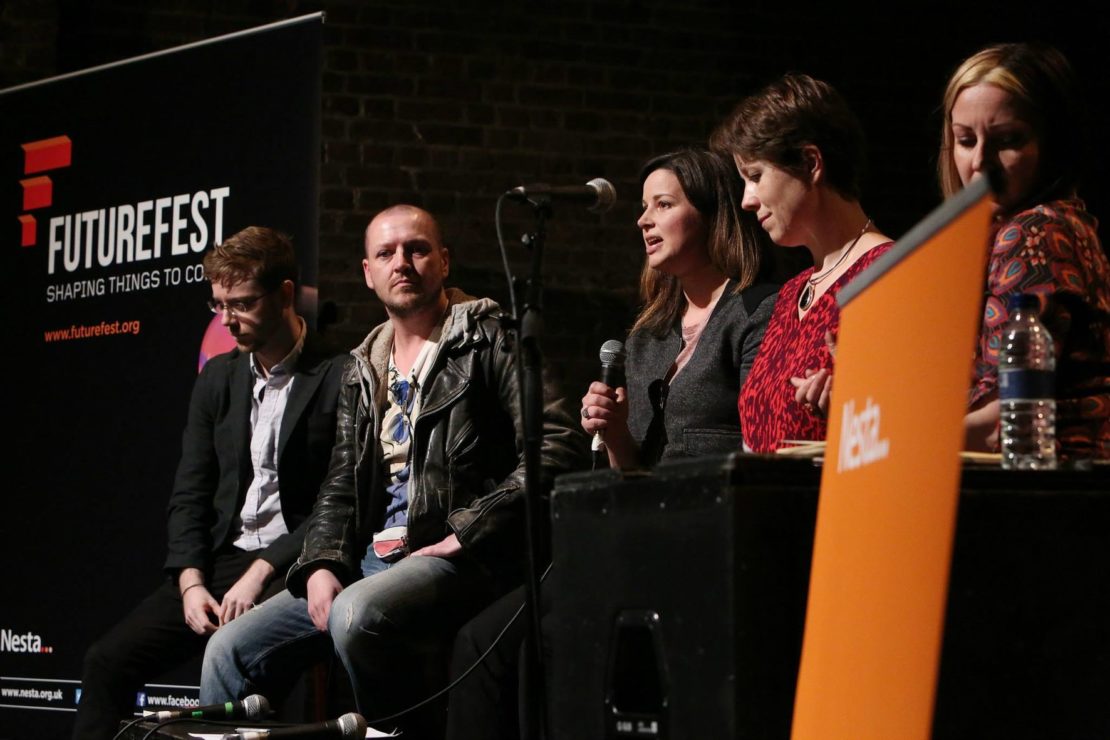Make your own virtual reality baby
Last week – the night before our Ready Player Two debate on the future of virtual realities – Microsoft unveiled a 3D version of the game Minecraft. You can now explore the world you build on Minecraft using the HoloLens headset to project it on to your coffee table. The whoop from the audience watching the demonstration at the E3 conference has a palpable level of honest thrill.
Tech giants are busy working on virtual reality headsets. Facebook's Oculus Rift is due to go on sale to the general public next spring. The Samsung Gear VR was created with Oculus to turn Samsung tablets and smartphones into virtual reality headsets. Oculus are now partnering with Xbox too. And of course, Google's Cardboard allows you to turn an Android phone into a headset for less than a tenner.

It's rare that the convergence of technology is so clearly visible. Microsoft, Facebook and Google are now so pregnant with virtual reality goodies that it's hard to see which baby is going to drop, and grow, first. It might just be whoever works out how to deal with motion sickness before anyone else.
There are also developments that could change the kinds of experiences that are possible. The HTC Re Vive headset has a controller that pairs with laser base stations. These track a player’s location in a room, allowing them to interact with games using their whole body. The base stations is designed to allow players to share a space physically and virtually at the same time.
It might soon be possible to watch almost real-time stereoscopic video. In July Google and GoPro’s project Jump will launch a special rig designed for 16 GoPro Hero4 cameras. Google will also release the blueprint to the rig so that anyone can build one of their own using a 3D printer. For anyone using the Jump set up, Google's servers will assemble the footage from the 16 cameras so that it can be viewed in stereoscopic VR on YouTube within 24 hours. YouTube already supports 360 video viewing on the Google Cardboard, as well as on some Apple devices. It's possible that by next year that you might not miss out on a wedding on the other side of the world. You could experience it from your sofa in London the morning after it happens.
Virtual worlds are limited by the mind of their creator
Ready Player One is set to be Steven Spielberg's first sci-fi film for a decade. It is the story of a future in which we spend most of our time in a virtual reality game called OASIS, while the world outside is ravaged by war and natural disasters. The game's designer has died, and his fortune is available to whoever can win the game. The environment and the clues in the game are based on the designer's own youth, mainly covering pop culture in the 80s.
Ready Player One depicts a virtual environment built on the home comforts of a specific generation in an even more specific cultural context. This fictional image of billions of people immersed in the imagination of single individual is a worrying extrapolation of some parts of today's virtual reality market. The generation buying the Oculus Rift are used to playing wildly successful video games built from the imaginations of a small group of people. Recent reminders that games design and science fiction are as political as their authors bring to mind questions about the ethics of living in virtual environments created by someone else.
Which is why Minecraft's new move into augmented reality is so exciting. It opens up the opportunity for more people to design their own worlds and stories. Just under a decade ago, the alternative world Second Life had millionaires in bidding wars over virtual real estate. Second Life's former CEO now has a new company, High Fidelity, that allows users to quickly construct their own virtual worlds. If you can code it in JavaScript, you can build basically anything into High Fidelity's worlds. Early users and the team's developers have generated cities and animals that move around realistically.

Google cardboard on the bus
The worlds inside games might be constrained by their designer. But so too are technologies built to support these worlds constrained by the imagination of their creators.
The long shadow of multiplayer games can get in the way of our view to wider, arguably more socially valuable uses of virtual reality, augmented reality and other kinds of layered digital and physical experiences. What are the really useful versions of this technology?
Most of the virtual reality demos available to consumers are simple games, where the user has to follow a fairly precise route through the experience. Others use 360 degree footage from bungee jumps or other extreme sports. You can imagine how this would be extended to sectors where experience is king – home buying or cheap holiday tours using headsets.
In some specialist contexts, virtual reality is already improving people's lives. Virtual reality used in laparoscopic surgery reduces surgery time and improves the performance of trainee surgeons. Virtual reality experiments where the race of the participant is changed has been shown to reduce implicit racial bias.
But it is in education and journalism that the first massive and socially valuable projects could come about. Schools could use Cardboard to take children on virtual expeditions, not just to the zoo but into the Milky Way. Virtual reality employed in Chris Milk's Clouds Over Sidra 360-degree film from a refugee camp in Jordan recently won the Interactive Award at the Sheffield Documentary Festival. A future where this kind of experience is possible in almost real time could revolutionise current affairs broadcasting.
Imagine sitting on the bus, unfolding your portable headset, and settling in to watch a three-minute stereoscopic report from an earthquake on another continent. This kind of presence in news stories might inspire a new sense of civic duty; or the immediacy of a tragedy might make you want to throw away the kit.
Smashing the screen
There is another generation of technologies that creates layers of reality in even more ambitious ways.
Augmented reality specialists Magic Leap are getting hyped in Hollywood as much as in Silicon Valley, by promising to make layers of augmentation over your everyday reality. There are also more intimate consumer technologies that mediate between the reality you perceive and your brain's reaction. The team behind the Thync plastic patch claim to be able to offer a calming effect in times of stress and an energy boost when concentration levels slump.
These create the potential for ever stranger feedback loops between reality and perception. What does it mean if neurological response and the world around us can now be overlaid on that world? Luciana Haill’s immersive art work Phrontesterion takes output from an audience member's brain activity and makes this part of their experience. She is starting to play with these new kinds of interactions that haven't found a home in our everyday lives just yet.
The possibilities of these technologies are vast. They disrupt our most immediate perceptions of reality, possibly to the point that we lose a clear sense of what we mean by reality.
Making the most of the pregnant pause
New headsets or brain-tracking devices could do many things. We're still playing around with possibilities – wrestling with the ways these change our realities. It makes it hard to pinpoint the most valuable uses for this new range of technologies.
But this is also an opportunity. Karl Popper worried about how much predictions can affect their own realisation: "I suggest the name 'Oedipus effect' for the influence of the prediction upon the predicted event (or, more generally, for the influence of an item of information upon the situation to which the information refers), whether this influence tends to bring about the predicted event, or whether it tends to prevent it."
This idea came from The Poverty of Historicism, his criticism of the kind of social science that sees historical prediction as its principal aim. But it can be applied more widely. By adding to the predictions for virtual reality, we can widen the ways it is used. We can use the Oedipus effect to our advantage.
There is huge investment in virtual reality technology. There are some clear early wins in existing markets such as the mainstream games industry. But then things get less easy to predict. And in the middle of this mess, there is a moment to sit back and think about what we really want to do. Let's not just fall back on virtual realities that are part of easy-to-reach fictions: OASIS in Ready Player One or the Metaverse in Neal Stephenson's Snow Crash. Let's play out the potential DIY virtual worlds of High Fidelity or what comes next after a virtual reality film that makes tech journalists cry.